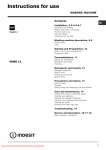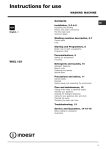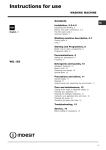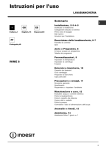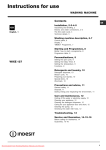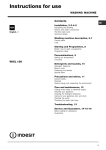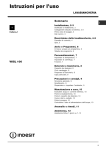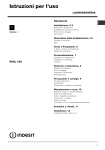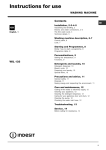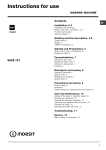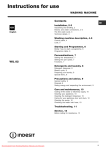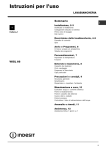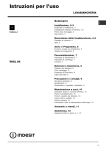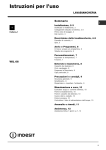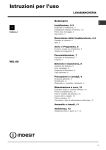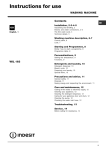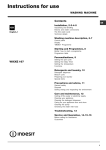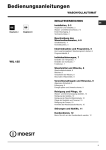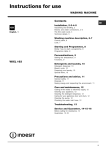Download Istruzioni per l`uso
Transcript
Istruzioni per luso LAVABIANCHERIA Sommario I Italiano,1 GB English,13 I Installazione, 2-3 Disimballo e livellamento, 2 Collegamenti idraulici ed elettrici, 2-3 Primo ciclo di lavaggio, 3 Dati tecnici, 3 Descrizione della lavabiancheria, 4-5 Pannello di controllo, 4 Spie, 5 Avvio e Programmi, 6 In breve: avviare un programma, 6 Tabella dei programmi, 6 Personalizzazioni, 7 WIL 85 Impostare la temperatura, 7 Impostare la centrifuga, 7 Funzioni, 7 Detersivi e biancheria, 8 Cassetto dei detersivi, 8 Ciclo candeggio, 8 Preparare la biancheria, 8 Capi particolari, 8 Precauzioni e consigli, 9 Sicurezza generale, 9 Smaltimento, 9 Risparmiare e rispettare lambiente, 9 Manutenzione e cura, 10 Escludere acqua e corrente elettrica, 10 Pulire la lavabiancheria, 10 Pulire il cassetto dei detersivi, 10 Curare oblò e cestello, 10 Pulire la pompa, 10 Controllare il tubo di alimentazione dellacqua, 10 Anomalie e rimedi, 11 Assistenza, 12 Assistenza Attiva 7 giorni su 7, 12 1 Installazione È importante conservare questo libretto per poterlo consultare in ogni momento. In caso di vendita, di cessione o di trasloco, assicurarsi che resti insieme alla lavabiancheria per informare il nuovo proprietario sul funzionamento e sui relativi avvertimenti. I Un accurato livellamento dà stabilità alla macchina ed evita vibrazioni, rumori e spostamenti durante il funzionamento. In caso di moquette o di un tappeto, regolare i piedini in modo da conservare sotto la lavabiancheria uno spazio sufficiente per la ventilazione. Leggere attentamente le istruzioni: ci sono importanti informazioni sullinstallazione, sulluso e sulla sicurezza. Collegamenti idraulici ed elettrici Disimballo e livellamento Collegamento del tubo di alimentazione dellacqua Disimballo 1. Disimballare la lavabiancheria. 2. Controllare che la lavabiancheria non abbia subìto danni nel trasporto. Se fosse danneggiata non collegarla e contattare il rivenditore. 3. Rimuovere le 3 viti di protezione per il trasporto e il gommino con il relativo distanziale, posti nella parte posteriore (vedi figura). 4. Chiudere i fori con i tappi di plastica in dotazione. 5. Conservare tutti i pezzi: qualora la lavabiancheria debba essere trasportata, dovranno essere rimontati. Gli imballaggi non sono giocattoli per bambini. Livellamento 1. Installare la lavabiancheria su un pavimento piano e rigido, senza appoggiarla a muri, mobili o altro. 2. Se il pavimento non fosse perfettamente orizzontale, compensare le irregolarità svitando o avvitando i piedini anteriori (vedi figura); langolo di inclinazione, misurato sul piano di lavoro, non deve superare i 2°. 2 A 1. Inserire la guarnizione A nellestremità del tubo di alimentazione e avvitarlo a un rubinetto dacqua fredda con bocca filettata da 3/4 gas (vedi figura). Prima di allacciare, far scorrere lacqua finché non sia limpida. 2. Collegare il tubo di alimentazione alla lavabiancheria avvitandolo allapposita presa dacqua, nella parte posteriore in alto a destra (vedi figura). 3. Fare attenzione che nel tubo non ci siano né pieghe né strozzature. La pressione idrica del rubinetto deve essere compresa nei valori della tabella Dati tecnici (vedi pagina a fianco). Se la lunghezza del tubo di alimentazione non fosse sufficiente, rivolgersi a un negozio specializzato o a un tecnico autorizzato. Non utilizzare mai tubi già usati. Collegamento del tubo di scarico I Il cavo non deve subire piegature o compressioni. Installazione 65 - 100 cm Collegare il tubo di scarico, senza piegarlo, a una conduttura di scarico o a uno scarico a muro posti tra 65 e 100 cm da terra; Non usare prolunghe e multiple. Il cavo di alimentazione deve essere sostituito solo da tecnici autorizzati. Attenzione! Lazienda declina ogni responsabilità qualora queste norme non vengano rispettate. Descrizione Primo ciclo di lavaggio Dopo linstallazione, prima delluso, effettuare un ciclo di lavaggio con detersivo e senza biancheria impostando il programma a 90°C senza prelavaggio. Programmi oppure appoggiarlo al bordo di un lavandino o di una vasca, legando la guida in dotazione al rubinetto (vedi figura). Lestremità libera del tubo di scarico non deve rimanere immersa nellacqua. Detersivi È sconsigliato usare tubi di prolunga; se indispensabile, la prolunga deve avere lo stesso diametro del tubo originale e non superare i 150 cm. Dati tecnici Prima di inserire la spina nella presa della corrente, accertarsi che: la presa abbia la messa a terra e sia a norma di legge; la tensione di alimentazione sia compresa nei valori indicati nella tabella Dati tecnici (vedi a fianco); La lavabiancheria non va installata allaperto, A lavabiancheria installata, la presa della corrente deve essere facilmente raggiungibile. larghezza cm 59,5 altezza cm 85 profondità cm 52,5 Capacità da 1 a 5 kg Collegamenti elettrici vedi la targhetta caratteristiche tecniche applicata sulla macchina Collegamenti idrici pressione massima 1 MPa (10 bar) pressione minima 0,05 MPa (0,5 bar) capacità del cesto 46 litri Velocità di centrifuga sino a 800 giri al minuto Programmi di controllo secondo la norma EN 60456 programma 2; temperatura 60°C; effettuato con 5 kg di carico. Questa apparecchiatura è conforme alle seguenti Direttive Comunitarie: - 89/336/CEE del 03/05/89 (Compatibilità Elettromagnetica) e successive modificazioni - 2006/95/CE (Bassa Tensione) - 2002/96/CE Assistenza nemmeno se lo spazio è riparato, perché è molto pericoloso lasciarla esposta a pioggia e temporali. Dimensioni Anomalie la presa sia compatibile con la spina della lavabiancheria. In caso contrario sostituire la presa o la spina. WIL 85 Manutenzione la presa sia in grado di sopportare il carico massimo di potenza della macchina, indicato nella tabella Dati tecnici (vedi a fianco); Modello Precauzioni Collegamento elettrico 3 Descrizione della lavabiancheria Pannello di controllo I Tasti FUNZIONE Spia ACCENSIONE/ Spie OBLÒ BLOCCATO Tasto ACCENSIONE/ SPEGNIMENTO Cassetto dei detersivi Manopola PROGRAMMI Tasto START/RESET Manopola CENTRIFUGA TEMPERATURA Cassetto dei detersivi per caricare detersivi e additivi (vedi pag. 8). Tasto START/RESET per avviare i programmi o annullare quanto erroneamente impostato. Spie per seguire lo stato di avanzamento del programma di lavaggio. Se è stata impostata la funzione Delay Timer, indicheranno il tempo mancante allavvio del programma (vedi pag. 5). Spia ACCENSIONE/OBLÒ BLOCCATO per capire se la lavabiancheria è accesa e se loblò è apribile (vedi pag. 5). Manopola CENTRIFUGA per impostare la centrifuga o escluderla (vedi pag. 7). Tasti FUNZIONE per selezionare le funzioni disponibili. Il tasto relativo alla funzione selezionata rimarrà acceso. Manopola TEMPERATURA per impostare la temperatura o il lavaggio a freddo (vedi pag. 7). 4 Manopola Tasto ACCENSIONE/SPEGNIMENTO per accendere e spegnere la lavabiancheria. Manopola PROGRAMMI per impostare i programmi (vedi pag. 6). Durante il programma la manopola resta ferma. Spie Ritardo impostato: Se è stata attivata la funzione Delay Timer (vedi pag. 7), dopo avere avviato il programma, inizierà a lampeggiare la spia relativa al ritardo selezionato: I Installazione Le spie forniscono informazioni importanti. Ecco che cosa dicono: Fase in corso: Durante il ciclo di lavaggio le spie si accenderanno progressivamente per indicarne lo stato di avanzamento: Prelavaggio Lavaggio Risciacquo Descrizione Centrifuga Nota: durante la fase di scarico si illuminerà la spia relativa alla fase Centrifuga. Trascorso il ritardo selezionato la spia lampeggiante si spengnerà e avrà inizio il programma impostato. Detersivi Tasti funzione I TASTI FUNZIONE fungono anche da spie. Selezionando una funzione il relativo tasto si illuminerà. Se la funzione selezionata non è compatibile con il programma impostato il tasto lampeggerà e la funzione non verrà attivata. Nel caso venga impostata una funzione incompatibile con unaltra precedentemente selezionata rimarrà attiva solo lultima scelta. Programmi Col trascorrere del tempo verrà visualizzato il ritardo residuo con il lampeggio della spia relativa: Precauzioni Manutenzione Anomalie Il lampeggio veloce della spia ACCENSIONE/OBLÒ BLOCCATO contemporaneo a quello di almeno unaltra spia segnala unanomalia (vedi pag. 11). Assistenza Spia ACCENSIONE/OBLÒ BLOCCATO: La spia accesa indica che loblò è bloccato per impedire aperture accidentali; per evitare danni è necessario attendere che la spia lampeggi prima di aprire loblò. 5 Avvio e Programmi In breve: avviare un programma I 5. Impostare la velocità di centrifuga (vedi pag. 7). 6. Versare detersivo e additivi (vedi pag. 8). 7. Avviare il programma premendo il tasto START/RESET. Per annullare il ciclo impostato premere il tasto START/RESET per 2 secondi. 8. Al termine del programma la spia ACCENSIONE/ OBLÒ BLOCCATO lampeggerà indicando che loblò è apribile. Estrarre la biancheria e lasciare loblò socchiuso per far asciugare il cestello. . Spegnere la lavabiancheria premendo il tasto 1. Accendere la lavabiancheria premendo il tasto . Tutte le spie si accenderanno per qualche secondo, poi si spengono e la spia ACCENSIONE/ OBLÒ BLOCCATO inizierà a lampeggiare. 2. Caricare la biancheria e chiudere loblò. 3. Impostare con la manopola PROGRAMMI il programma desiderato. 4. Impostare la temperatura di lavaggio (vedi pag. 7). Tabella dei programmi N atura d ei tessuti e dello sp orco P rogram m i Tem p eratura D urata Op zione D escrizione del ciclo d i A m m orbiAntimacchia / del ciclo lavaggio dente (m inuti) C and eggina prelav. lavag . D etersivo S tandard Cotone: Bianchi estremamente 1 90°C 2 90°C 2 60°C 2 40°C 3 40°C 4 60°C D elicata 80 4 40°C D elicata 71 5 40°C D elicata 71 L an a 6 40°C 50 Tessu ti molto delicati (ten de, seta, viscosa, ecc.) 7 30°C 52 8 60°C 60 9 40°C 50 10 4 0 °C 40 11 30°C 30 Scarpe sportive (MAX. 2 paia) 12 30 °C 50 Tessuti per abbigliamento sportivo (Tute, calzoncini, ecc.) 13 30°C 63 sporchi (lenzuola, tovaglie, ecc.) Cotone: Bianchi estremamente sporchi (lenzuola, tovaglie, ecc.) Cotone: Bianchi e colorati resistenti molto sporchi Cotone: Bianchi e colorati delicati molto sporchi Cotone: Bianchi poco sporchi e colori delicati (camice, maglie, ecc.) Sintetici: Colori resistenti molto sporchi (biancheria per neonati, ecc.) Sintetici: Colori resistenti molto sporchi (biancheria per neonati, ecc.) Sintetici: Colori delicati (biancheria di tutti i tipi leggermente sporca) 167 D elicata / Tradizion ale D elicata / Tradizion ale D elicata / Tradizion ale D elicata / Tradizion ale 152 158 143 99 Prelavaggio, lavaggio, risciacqui, centrifughe intermedie e finale Lavaggio, risciacqui, centrifughe intermedie e finale Lavaggio, risciacqui, centrifughe intermedie e finale Lavaggio, risciacqui, centrifughe intermedie e finale Lavaggio, risciacqui, centrifughe intermedie e finale L avaggio, risciacqu i, an tipiega o cen trifu ga delicata L avaggio, risciacqu i, an tipiega o cen trifu ga delicata L avaggio, risciacqu i, an tipiega o cen trifu ga delicata L avaggio, risciacqu i, cen trifu ga delicata L avaggio, risciacqu i, an tipiega o scarico Tim e 4 y o u Cotone: Bianchi e colorati resistenti molto sporchi Cotone: Bianchi poco sporchi e colori delicati (camice, maglie, ecc.) Sintetici: Colori delicati (biancheria di tutti i tipi leggermente sporca) Sintetici: Colori delicati (biancheria di tutti i tipi leggermente sporca) Lavaggio, risciacqui, centrifughe intermedie e finale Lavaggio, risciacqui, centrifughe intermedie e finale L avaggio, risciacqu i, cen trifu ga delicata L avaggio, risciacqu i, e cen trifu ga delicata S po rt L avaggio a freddo (senza detersivo), lavaggio, risciacqui, e centrifuga delicata L avaggio, risciacqu i, cen trifu gh e in termedie e fin ale P R OGR AM M I PAR Z IALI R isciacqu o D elicata / Tradizion ale R isciacqu i e cen trifu ga Cen trifu ga Scarico e cen trifu ga Scarico Scarico Note -Per i programmi 8 e 9 è consigliabile non superare un carico di biancheria di 3,5 kg. -Per il programma 13 è consigliabile non superare un carico di biancheria di 2 kg. -Per la descrizione dellantipiega: vedi Stira meno, pagina a fianco. I dati riportati nella tabella hanno valore indicativo. Programma speciale Refresh (programma 11 per Sintetici) è studiato per lavare capi leggermente sporchi in poco tempo: dura solo 30 minuti e fa così risparmiare energia e tempo. Impostando il programma (11 a 30°C) è possibile lavare insieme tessuti di diversa natura (esclusi lana e seta) con un carico massimo di 3 kg. Si consiglia l'uso di detersivo liquido. 6 Personalizzazioni C Impostare la temperatura I Ruotando la manopola TEMPERATURA si imposta la temperatura di lavaggio (vedi Tabella dei programmi a pag. 6). La temperatura si può ridurre sino al lavaggio a freddo ( ). Installazione Impostare la centrifuga Le varie funzioni di lavaggio previste dalla lavabiancheria permettono di ottenere la pulizia e il bianco desiderati. Per attivare le funzioni: 1. premere il tasto relativo alla funzione desiderata, secondo la tabella sottostante; 2. laccensione del tasto relativo segnala che la funzione è attiva. Attiva con i programmi: Delay Timer Ritarda l'avvio della macchina sino a 9 ore. Premere più volte il tasto fino a far acccendere la spia relativa al ritardo desiderato. Alla quinta pressione del tasto la funzione si disattiverà. N.B.: Una volta premuto il tasto Start/Reset, si può modificare il valore del ritardo solo diminuendolo. Tutti Ciclo di candeggio adatto a eliminare le macchie più resistenti. Ricordarsi di versare la candeggina nella vaschetta aggiuntiva 4 (vedi pag. 8). Non è compatibile con l'opzione STIRA MENO. 2, 3, 4, 5, Risciacquo. Riduce le pieghe sui tessuti, agevolando la stiratura. Impostando questa funzione, i programmi 4, 5, 7 si interromperanno con il bucato in ammollo (Antipiega) e la spia della fase Risciacquo lampeggerà: - per completare il ciclo premere il tasto START/RESET; - per effettuare solo lo scarico posizionare la manopola sul simbolo relativo e premere il tasto START/RESET. Non è compatibile con l'opzione ANTIMACCHIA. 3, 4, 5, 7, 8, 9, 10, Risciacquo. Aumenta l'efficacia del risciacquo. E' consigliata con lavabiancheria a pieno carico o con dosi elevate di detersivo. 1, 2, 3, 4, 5, 8, 9, 10,12, 13 Risciacquo. Antimacchia Stira meno Extra Risciacquo Assistenza Note per l'uso Anomalie Effetto Manutenzione Funzioni Precauzioni Nota: Il lampeggio veloce del tasto indica che la funzione relativa non è selezionabile per il programma impostato. Detersivi Funzioni Programmi . La velocità di centrifuga può essere ridotta, oppure esclusa selezionando il simbolo La macchina impedirà automaticamente di effettuare una centrifuga maggiore a quella massima prevista per ogni programma. Nota: Per evitare vibrazioni eccessive prima di ogni centrifuga la macchina distribuisce il carico in modo uniforme, questo avviene effettuando delle rotazioni continue del cesto ad una velocità leggermente superiore a quella di lavaggio. Quando nonostante ripetuti tentativi il carico non viene perfettamente distribuito, la macchina effettua la centrifuga ad una velocità inferiore a quella prevista. In presenza di eccessivo sbilanciamento la macchina effettua la distribuzione al posto della centrifuga. Gli eventuali tentativi di bilanciamento possono allungare la durata totale del ciclo fino ad un massimo di 10 minuti. Descrizione Ruotando la manopola CENTRIFUGA si imposta la velocità di centrifuga del programma selezionato. Le velocità massime previste per i programmi sono: Programmi Velocità massima Cotone 800 giri al minuto Sintetici 800 giri al minuto Lana 600 giri al minuto Seta no 7 Detersivi e biancheria I Cassetto dei detersivi Preparare la biancheria Il buon risultato del lavaggio dipende anche dal corretto dosaggio del detersivo: eccedendo non si lava in modo più efficace e si contribuisce a incrostare le parti interne della lavabiancheria e a inquinare lambiente. Suddividere la biancheria secondo: - il tipo di tessuto / il simbolo sulletichetta. - i colori: separare i capi colorati da quelli bianchi. Vuotare le tasche e controllare i bottoni. Non superare i valori indicati, riferiti al peso della biancheria asciutta: Tessuti resistenti: max 5 kg Tessuti sintetici: max 2,5 kg Tessuti delicati: max 2 kg Lana: max 1 kg 4 1 2 3 Estrarre il cassetto dei detersivi e inserire il detersivo o ladditivo come segue. Quanto pesa la biancheria? vaschetta 1: Detersivo per prelavaggio (in polvere) Prima di versare il detersivo verificare che non sia inserita la vaschetta aggiuntiva 4. vaschetta 2: Detersivo per lavaggio (in polvere o liquido) Il detersivo liquido va versato solo prima dellavvio. vaschetta 3: Additivi (ammorbidente, ecc.) Lammorbidente non deve fuoriuscire dalla griglia. vaschetta aggiuntiva 4: Candeggina Non usare detersivi per il lavaggio a mano, perché formano troppa schiuma. Ciclo candeggio La candeggina tradizionale si usa per i tessuti resistenti bianchi, quella delicata per i tessuti colorati, i sintetici e per la lana. Inserire la vaschetta aggiuntiva 4, in dotazione, nella vaschetta 1. Nel dosare la candeggina non superare il livello max indicato sul perno centrale (vedi figura). Per effettuare solo il candeggio versare la candeggina nella vaschetta aggiuntiva 4, impostare il programma e attivare la funzione Antimacchia Risciacquo (vedi pag. 7). Per candeggiare durante il lavaggio versare il detersivo e gli additivi, impostare il programma desiderato e attivare la funzione Antimacchia (vedi pag. 7). Lutilizzo della vaschetta aggiuntiva 4 esclude il prelavaggio. 8 1 1 1 1 1 lenzuolo 400-500 gr. federa 150-200 gr. tovaglia 400-500 gr. accappatoio 900-1.200 gr. asciugamano 150-250 gr. Capi particolari Tende: piegarle e sistemarle dentro una federa o un sacchetto a rete. Lavarle da sole senza superare il mezzo carico. Utilizzare il programma 7 che esclude in automatico la centrifuga. Piumini e giacche a vento: se limbottitura è doca o danatra si possono lavare nella lavabiancheria. Rivoltare i capi e fare un carico massimo di 2-3 kg, ripetendo il risciacquo una o due volte e utilizzando la centrifuga delicata. Lana: per ottenere i migliori risultati utilizzare un detersivo specifico e non superare 1kg di carico. Precauzioni e consigli Sicurezza generale Questo apparecchio è stato concepito esclusivamente per un uso di tipo domestico. Non toccare la macchina a piedi nudi o con le mani o i piedi bagnati o umidi. Non aprire il cassetto dei detersivi mentre la macchina è in funzione. Non forzare in nessun caso loblò: potrebbe danneggiarsi il meccanismo di sicurezza che protegge da aperture accidentali. Controllare sempre che i bambini non si avvicinino alla macchina in funzione. Durante il lavaggio loblò tende a scaldarsi. Prima di introdurre la biancheria controlla che il cestello sia vuoto. Smaltimento del materiale di imballaggio: attenersi alle norme locali, così gli imballaggi potranno essere riutilizzati. Dosare bene il detersivo in base alla durezza dellacqua, al grado di sporco e alla quantità di biancheria evita sprechi e protegge lambiente: pur biodegradabili, i detersivi contengono elementi che alterano lequilibrio della natura. Inoltre evitare il più possibile lammorbidente. Effettuando i lavaggi dal tardo pomeriggio fino alle prime ore del mattino si collabora a ridurre il carico di assorbimento delle aziende elettriche. La funzione Delay Timer (vedi pag. 7) aiuta molto a organizzare i lavaggi in tal senso. Se il bucato deve essere asciugato in un asciugatore, selezionare unalta velocità di centrifuga. Poca acqua nel bucato fa rispamiare tempo ed energia nel programma di asciugatura. Assistenza La direttiva Europea 2002/96/CE sui rifiuti di apparecchiature elettriche ed elettroniche, prevede che gli elettrodomestici non debbano essere smaltiti nel normale flusso dei rifiuti solidi urbani. Gli apparecchi dismessi devono essere raccolti Trattando le macchie con uno scioglimacchia o lasciandole in ammollo prima del lavaggio, si riduce la necessità di lavare ad alte temperature. Un programma a 60°C invece di 90°C o uno a 40°C invece di 60°C, fa risparmiare fino al 50% di energia. Anomalie Smaltimento Il prelavaggio è necessario solo per biancheria molto sporca. Evitarlo fa risparmiare detersivo, tempo, acqua e tra il 5 e il 15% di energia. Manutenzione Se devessere spostata, lavorare in due o tre persone con la massima attenzione. Mai da soli perché la macchina è molto pesante. Risparmiare detersivo, acqua, energia e tempo Per non sprecare risorse bisogna utilizzare la lavabiancheria con il massimo carico. Un carico pieno al posto di due mezzi fa risparmiare fino al 50% di energia. Precauzioni In caso di guasto, in nessun caso accedere ai meccanismi interni per tentare una riparazione. Tecnologia a servizio dellambiente Se nelloblò si vede poca acqua è perché con la nuova tecnologia Indesit basta meno della metà dellacqua per raggiungere il massimo pulito: uno scopo raggiunto per rispettare lambiente. Detersivi Non toccare lacqua di scarico, che può raggiungere temperature elevate. Risparmiare e rispettare lambiente Programmi Non staccare la spina dalla presa della corrente tirando il cavo, bensì afferrando la spina. I Descrizione La lavabiancheria deve essere usata solo da persone adulte e secondo le istruzioni riportate in questo libretto. separatamente per ottimizzare il tasso di recupero e riciclaggio dei materiali che li compongono ed impedire potenziali danni per la salute e l'ambiente. Il simbolo del cestino barrato è riportato su tutti i prodotti per ricordare gli obblighi di raccolta separata. Per ulteriori informazioni, sulla corretta dismissione degli elettrodomestici, i detentori potranno rivolgersi al servizio pubblico preposto o ai rivenditori. Installazione La lavabiancheria è stata progettata e costruita in conformità alle norme internazionali di sicurezza. Queste avvertenze sono fornite per ragioni di sicurezza e devono essere lette attentamente. 9 Manutenzione e cura I Escludere acqua e corrente elettrica Pulire la pompa Chiudere il rubinetto dellacqua dopo ogni lavaggio. Si limita così lusura dellimpianto idraulico della lavabiancheria e si elimina il pericolo di perdite. La lavabiancheria è dotata di una pompa autopulente che non ha bisogno di manutenzione. Può però succedere che piccoli oggetti (monete, bottoni) cadano nella precamera che protegge la pompa, situata nella parte inferiore di essa. Staccare la spina della corrente quando si pulisce la lavabiancheria e durante i lavori di manutenzione. Assicurarsi che il ciclo di lavaggio sia terminato e staccare la spina. Pulire la lavabiancheria Per accedere alla precamera: La parte esterna e le parti in gomma possono essere puliti con un panno imbevuto di acqua tiepida e sapone. Non usare solventi o abrasivi. Pulire il cassetto dei detersivi Sfilare il cassetto sollevandolo e tirandolo verso lesterno (vedi figura). Lavarlo sotto lacqua corrente; questa pulizia va effettuata frequentemente. 1. rimuovere il pannello di copertura sul lato anteriore della lavabiancheria con lausilio di un giravite (vedi figura); 2. svitare il coperchio ruotandolo in senso antiorario (vedi figura): è normale che fuoriesca un po dacqua; Curare oblò e cestello Lasciare sempre socchiuso loblò per evitare che si formino cattivi odori. 3. pulire accuratamente linterno; 4. riavvitare il coperchio; 5. rimontare il pannello assicurandosi, prima di spingerlo verso la macchina, di aver inserito i ganci nelle apposite asole. Controllare il tubo di alimentazione dellacqua Controllare il tubo di alimentazione almeno una volta allanno. Se presenta screpolature e fessure va sostituito: durante i lavaggi le forti pressioni potrebbero provocare improvvise spaccature. Non utilizzare mai tubi già usati. 10 Anomalie e rimedi Può accadere che la lavabiancheria non funzioni. Prima di telefonare allAssistenza (vedi pag. 12), controllare che non si tratti di un problema facilmente risolvibile aiutandosi con il seguente elenco. Il tubo di alimentazione dellacqua non è collegato al rubinetto. Il tubo è piegato. Il rubinetto dellacqua non è aperto. In casa manca lacqua. Non cè sufficiente pressione. Il tasto START/RESET non è stato premuto. La lavabiancheria carica e scarica acqua di continuo. Il tubo di scarico non è installato fra 65 e 100 cm da terra (vedi pag. 3). Lestremità del tubo di scarico è immersa nellacqua (vedi pag. 3). Lo scarico a muro non ha lo sfiato daria. Se dopo queste verifiche il problema non si risolve, chiudere il rubinetto dellacqua, spegnere la lavabiancheria e chiamare lAssistenza. Se labitazione si trova agli ultimi piani di un edificio, è possibile che si verifichino fenomeni di sifonaggio, per cui la lavabiancheria carica e scarica acqua di continuo. Per eliminare linconveniente sono disponibili in commercio apposite valvole anti-sifonaggio. La lavabiancheria non scarica o non centrifuga. Il programma non prevede lo scarico: con alcuni programmi occorre avviarlo manualmente (vedi pag. 6). È attiva la funzione Stira meno: per completare il programma premere il tasto START/RESET (vedi pag. 7). Il tubo di scarico è piegato (vedi pag. 3). La conduttura di scarico è ostruita. La lavabiancheria vibra molto durante la centrifuga. Il cestello, al momento dellinstallazione, non è stato sbloccato correttamente (vedi pag. 2). La lavabiancheria non è in piano (vedi pag. 2). La lavabiancheria è stretta tra mobili e muro (vedi pag. 2). La lavabiancheria perde acqua. Il tubo di alimentazione dellacqua non è ben avvitato (vedi pag. 2). Il cassetto dei detersivi è intasato (per pulirlo vedi pag. 10). Il tubo di scarico non è fissato bene (vedi pag. 3). La spia ACCENSIONE/OBLÒ BLOCCATO lampeggia in modo veloce contemporaneamente ad almeno unaltra spia. Spegnere la macchina e togliere la spina dalla presa, attendere circa 1 minuto quindi riaccenderla. Se lanomalia persiste, chiamare lAssistenza. Si forma troppa schiuma. Il detersivo non è specifico per lavabiancheria (deve esserci la dicitura per lavatrice, a mano e in lavatrice, o simili). Il dosaggio è stato eccessivo. Assistenza La lavabiancheria non carica acqua. Anomalie Loblò non è ben chiuso non è stato premuto. Il tasto Il tasto START/RESET non è stato premuto. Il rubinetto dellacqua non è aperto. Si è impostato un ritardo sullora di avvio (Delay Timer, vedi pag. 7). Manutenzione Precauzioni Il ciclo di lavaggio non inizia. Detersivi La spina non è inserita nella presa della corrente, o non abbastanza da fare contatto. In casa non cè corrente. Programmi La lavabiancheria non si accende. Descrizione Possibili cause / Soluzione: Installazione Anomalie: I 11 Assistenza Prima di contattare lAssistenza: Verificare se lanomalia può essere risolta da soli (vedi pag. 11); Riavviare il programma per controllare se linconveniente è stato ovviato; In caso negativo, contattare il Numero Unico 199.199.199 *; I Non ricorrere mai a tecnici non autorizzati. Comunicare: il tipo di anomalia; il modello della macchina (Mod.); il numero di serie (S/N); Queste informazioni si trovano sulla targhetta applicata nella parte posteriore della lavabiancheria. Assistenza Attiva 7 giorni su 7 * Assistenza Se nasce il bisogno di assistenza o manutenzione basta chiamare il Numero Unico 199.199.199* per essere messi subito in contatto con il Centro Assistenza Tecnica più vicino al luogo da cui si chiama. È attivo 7 giorni su 7, sabato e domenica compresi, e non lascia mai inascoltata una richiesta. 12 * Al costo di 14,25 centesimi di Euro al minuto(iva inclusa) dal Lun. al Ven. dalle 08:00 alle 18:30, il Sab. dalle 08:00 alle 13:00 e di 5,58 centesimi di Euro al minuto (iva inclusa) dal Lun. al Ven. dalle 18:30 alle 08:00, il Sab. dalle 13:00 alle 08:00 e i giorni festivi, per chi chiama da telefono fisso. Per chi chiama da radiomobile le tariffe sono legate al piano tariffario delloperatore telefonico utilizzato. Instructions for use WASHING MACHINE Contents GB English GB Installation, 14-15 Unpacking and levelling, 14 Electric and water connections, 14-15 The first wash cycle, 15 Technical details, 15 Washing machine description, 16-17 Control panel, 16 Leds, 17 Starting and Programmes, 18 Briefly: how to start a programme, 18 Programme table, 18 Personalisations, 19 WIL 85 Setting the temperature, 19 Setting the spin speed, 19 Functions, 19 Detergents and laundry, 20 Detergent dispenser, 20 Bleach cycle, 20 Preparing your laundry, 20 Special items, 20 Precautions and advice, 21 General safety, 21 Disposal, 21 Saving energy and respecting the environment, 21 Care and maintenance, 22 Cutting off the water or electricity supply, 22 Cleaning your appliance, 22 Cleaning the detergent dispenser, 22 Caring for your appliance door and drum, 22 Cleaning the pump, 22 Checking the water inlet hose, 22 Troubleshooting, 23 Service, 24 Before calling for Assistance, 24 13 Installation GB Keep this instruction manual in a safe place for future reference. Should the appliance be sold, transferred or moved, make sure the instruction manual accompanies the washing machine to inform the new owner as to its operation and features. Read these instructions carefully: they contain vital information on installation, use and safety. Unpacking and levelling Levelling your appliance correctly will provide it with stability and avoid any vibrations, noise and shifting during operation. If it is placed on a fitted or loose carpet, adjust the feet in such a way as to allow enough room for ventilation beneath the washing machine. Electric and water connections Connecting the water inlet hose Unpacking 1. Unpack the washing machine. 2. Check whether the washing machine has been damaged during transport. If this is the case, do not install it and contact your retailer. 3. Remove the 3 protective screws and the rubber washer with the respective spacer, situated on the rear of the appliance (see figure). 4. Seal the gaps using the plastic plugs provided. 5. Keep all the parts: you will need them again if the washing machine needs to be moved to another location. Packaging materials are not children's toys. Levelling 1. Install the washing machine on a flat sturdy floor, without resting it up against walls, furniture cabinets or other. 2. If the floor is not perfectly level, compensate for any unevenness by tightening or loosening the adjustable front feet (see figure); the angle of inclination, measured according to the worktop, must not exceed 2°. 14 A 1. Insert seal A into the end of the inlet hose and screw the latter onto a cold water tap with a 3/4 gas threaded mouth (see figure). Before making the connection, allow the water to run freely until it is perfectly clear. 2. Connect the other end of the water inlet hose to the washing machine, screwing it onto the appliance's cold water inlet, situated on the top right-hand side on the rear of the appliance (see figure). 3. Make sure there are no kinks or bends in the hose. The water pressure at the tap must be within the values indicated in the Technical details table (on the next page). If the water inlet hose is not long enough, contact a specialist store or an authorised serviceman. Never use hoses that have already been used. Do not use extensions or multiple sockets. Connecting the drain hose The power supply cable must never be bent or dangerously compressed. The power supply cable must only be replaced by an authorised serviceman. GB Installation 65 - 100 cm Connect the drain hose, without bending it, to a draining duct or a wall drain situated between 65 and 100 cm from the floor; Warning! The company denies all liability if and when these norms are not respected. Before plugging the appliance into the mains socket, make sure that: the socket is earthed and in compliance with the applicable law; the socket is compatible with the washing machine's plug. If this is not the case, replace the socket or the plug. The washing machine should not be installed in an When the washing machine is installed, the mains socket must be within easy reach. 59.5 cm wide 85 cm high 52.5 cm deep Capacity from 1 to 5 kg Electric connections please refer to the technical data plate fixed to the machine Water connections maximum pressure 1 MPa (10 bar) minimum pressure 0.05 MPa (0.5 bar) drum capacity 46 litres Spin speed up to 800 rpm Control programmes according to EN 60456 directive programme 2; temperature 60°C; run with a load of 5 kg. This appliance is compliant with the following European Community Directives: - 89/336/CEE of 03/05/89 (Electromagnetic Compatibility) and subsequent amendments - 2006/95/CE (Low Voltage) - 2002/96/CE Service outdoor environment, not even when the area is sheltered, because it may be very dangerous to leave it exposed to rain and thunderstorms. Dimensions Troubleshooting the supply voltage is included within the values i ndicated on the Technical details table (on the right); WIL 85 Care the socket is able to sustain the appliance's maximum power load indicated in the Technical details table (on the right); Model Precautions Electric connection Technical details Detergents We advise against the use of hose extensions; in case of absolute need, the extension must have the same diameter as the original hose and must not exceed 150 cm in length. Once the appliance has been installed, and before you use it for the first time, run a wash cycle with detergent and no laundry, setting the 90°C programme without a pre-wash cycle. Programmes alternatively, place it over the edge of a basin, sink or tub, fastening the duct supplied to the tap (see figure). The free end of the hose should not be underwater. Description The first wash cycle 15 Washing machine description Control panel GB FUNCTION Buttons Leds ON-OFF/ DOOR ON-OFF LOCK Button Led PROGRAMME Knob Detergent dispenser START/RESET Button TEMPERATURE SPIN SPEED Knob Knob Detergent dispenser: to add detergent and fabric softener (see page 20). TEMPERATURE knob: to set the temperature or the cold wash cycle (see page 19). LEDS: to find out which wash cycle phase is under way. If the Delay Timer function has been set, the time left until the programme starts will be indicated (see page 17). START/RESET button: to start the programmes or cancel any incorrect settings. SPIN SPEED knob: to set the spin speed or exclude the spin cycle completely (see page 19). FUNCTION buttons: to select the functions available. The button corresponding to the function selected will remain on. 16 ON-OFF/DOOR LOCK Led: to find out whether the washing machine is on and if the appliance door can be opened (see page 17). ON/OFF button: to turn the washing machine on and off. PROGRAMME knob: to select the wash programmes. The knob stays still during the cycle. Leds Delay set: If the Delay Timer function has been enabled (see page. 19), once you have started the programme, the LED corresponding to the delay set will begin to flash: Prewash Wash Rinse Note: during draining, the LED corresponding to the Spin cycle phase will be turned on. Detergents Once the set delay is complete, the flashing LED will turn off and the programme set will start. Programmes As time passes, the remaining delay will be displayed, and the corresponding LED will flash: Description Spin cycle Function buttons The FUNCTION BUTTONS also act like LEDS. When a function is selected, the corresponding button is illuminated. If the function selected is incompatible with the programme set, the button will flash and the function will not be enabled. If you set a function that is incompatible with another function you selected previously, only the last one selected will be enabled. GB Installation The LEDS provide important information. This is what they can tell you: Cycle phase under way: During the wash cycle, the LEDs gradually illuminate on to indicate the cycle phase under way: Precautions Care Troubleshooting The rapid flashing of the ON-OFF/DOOR LOCK Led together with the flashing of at least one other LED indicates there is an abnormality (see page 23). Service ON-OFF/DOOR LOCK led: If this LED is on, the appliance door is locked to prevent it from being opened accidentally; to avoid any damages, wait for the LED to flash before you open the appliance door. 17 Starting and Programmes Briefly: starting a programme GB 6. Add the detergent and any fabric softener (see page 20). 7. Start he programme by pressing the START/RESET button. To cancel it, keep the START/RESET button pressed for at least 2 seconds. 8. When the programme is finished, the ON-OFF/ DOOR LOCK Led will flash to indicate that the appliance door can be opened. Take out your laundry and leave the appliance door ajar to allow the drum to dry thoroughly. Turn the washing . machine off by pressing button 1. Switch the washing machine on by pressing button . All the LEDS will light up for a few seconds and the ON-OFF/DOOR LOCK Led will begin to flash. 2. Load your laundry into the washing machine and shut the appliance door. 3. Set the PROGRAMME knob to the programme required. 4. Set the wash temperature (see page 19). 5. Set the spin speed (see page 19). Programme table Typ e of fa b ric a nd d e gre e of soil P rogra m m e s Te m p e ra ture D e te rge nt Fab ric softener prew as h w as h C ycle Sta in re m ova l length op tion /b le a c h (m inute s) D e sc rip tion of w a sh c yc le S tandard C otton: Extremely soiled w hites Pre-wash, wash cycle, rinse cycles, intermediate and final spin cycles Wash cycle, rinse cycles, intermediate and final spin cycles Wash cycle, rinse cycles, intermediate and final spin cycles Wash cycle, rinse cycles, intermediate and final spin cycles 1 9 0°C 2 9 0°C 2 6 0°C 2 4 0°C 3 4 0°C D elicate/ Tradition al 99 4 6 0°C D elicate 80 4 4 0°C D elicate 71 5 4 0°C D elicate 71 W oo l 6 4 0°C 50 Very delicate fabrics (cu rtain s , s ilk, vis cos e, etc.) 7 3 0°C 52 8 6 0°C 60 Wash cycle, rinse cycles, intermediate and final spin cycles 9 4 0°C 50 Wash cycle, rinse cycles, intermediate and final spin cycles 10 40 °C 40 11 3 0°C 30 Sports shoes (MAX. 2 pairs) 12 30 °C 50 Cold w ash (w ithout detergents), w ash cycle, rin se cycles, and delicate spin cycle Fabrics for sportsw ear (Tracksuits, sh orts, etc.) 13 3 0°C 63 Wash cycle, rinse cycles, intermediate and final spin cycles (sheets, tablecloths, etc.) C otton: Extremely soiled w hites (sheets, tablecloths, etc.) C otton: Heavily soiled w h ites and fast colours C otton: Heavily soiled w h ites and delicate colours C otton: Sligh tly s oiled w h ites an d delicate colours (sh irts , ju mpers, etc.) Synthetics: Heavily soiled fast colours (baby linen, etc.) Synthetics: Heavily soiled fast colours (baby linen, etc.) Synthetics: Delicate colours (all types of slightly soiled garments) 167 D elicate/ Tradition al D elicate/ Tradition al D elicate/ Tradition al 152 158 143 Wash cycle, rinse cycles, intermediate and final spin cycles Was h cycle, rin se cycles , an ticrease or delicate spin cycle Was h cycle, rin se cycles , an ticrease or delicate spin cycle Was h cycle, rin se cycles , an ticrease or delicate spin cycle W as h cycle, rin s e cycles an d delicate s p in cycle W as h cycle, rin s e cycles , an ticreas e o r drain in g cycle Tim e 4 y o u C otton: Heavily soiled w h ites and fast colours C otton: Sligh tly s oiled w h ites an d delicate colours (sh irts , ju mpers, etc.) Synthetics: Delicate colours (all types of slightly soiled garments) Synthetics: Delicate colours (all types of slightly soiled garments) Was h cycle, rin se cycles , delicate s pin cycle W as h cycle, rin s e cycles an d delicate s p in cycle S po rt PAR TIAL P R OGR AM M E S R in s e D elicate/ Tradition al R in s e cycles an d s pin cycle Spin cycle Draining and spin cycle D rain D rain in g Notes -For programmes 8 and 9, we advise against exceeding a wash load of 3.5 kg. -For programme 13 we advise against exceeding a wash load of 2 kg. -For the anti-crease function: see Easy iron, opposite page. The information contained in the table is purely indicative. Special programme Daily (programme 11 for Synthetics) is designed to wash lightly soiled garments in a short amount of time: it only lasts 30 minutes and allows you to save on both time and energy. By setting this programme (11 at 30°C), you can wash different fabrics together (except for woollen and silk items), with a maximum load of 3 kg. We recommend the use of liquid detergent. 18 Personalisations Setting the temperature Turn the TEMPERATURE knob to set the wash temperature (see Programme table on page 18). The temperature can be lowered, or even set to a cold wash ( ). GB Installation Setting the spin speed Detergents Functions Programmes . The spin speed can be lowered, or the spin cycle can be excluded altogether by selecting symbol The washing machine will automatically prevent you from selecting a spin speed higher than the maximum speed for each programme. Note: to avoid excessive vibrations, before every spin cycle the machine distributes the load in a uniform manner by continuously rotating the drum at a speed which is slightly faster than the normal washing speed. When, despite repeated attempts, the load is still not evenly distributed, the machine spins at a lower speed than the set frequency. If the load is excessively unbalanced, the machine attempts to distribute it instead of spinning. The balancing attempts may extend the total duration of the cycle, up to a maximum of 10 minutes. Description Turn the SPIN SPEED knob to set the spin speed for the programme selected. The maximum spin speeds for each programme are as follows: Programmes Maximum spin speed Cottone 800 rpm Synthetics 800 rpm Wool 600 rpm Silk no To enable a function: 1. press the button corresponding to the desired function, according to the table below; 2. the function is enabled when the corresponding button is illuminated. Note: The rapid flashing of the button indicates that the corresponding function cannot be selected for the programme set. Delay Timer Extra Rinse Enabled with programmes: Delays the start of the wash by up to 9 hours. Press the button repeatedly until the LED corresponding to the desired delay is turned on. The fifth time the button is pressed, the function will be disabled. N.B.: Once you have pressed the Start/Reset button, the delay can only be decreased if you wish to modify it. All Bleaching cycle designed to remove the toughest stains. Please remember to pour the bleach into extra compartment 4 (see page 20). This function is incompatible with the EASY IRON function. 2, 3, 4, 5, Rinse cycle. This option reduces the amount of creasing on fabrics, making them easier to iron. When this function is set, programmes 4, 5, 7 will end with the laundry left to soak (Anti-crease) and the Rinse cycle phase LED will flash. - to conclude the cycle, press the START/RESET button; - to run the draining cycle alone, set the knob to the relative symbol and press the START/RESET button. This function is incompatible with the STAIN REMOVAL function. 3, 4, 5, 7, 8, 9, 10, Rinse cycle. Increases the efficiency of the rinse. Recommended when the appliance has a full load or with large quantities of detergent. 1, 2, 3, 4, 5, 8, 9, 10, 12, 13, Rinse cycle. Troubleshooting Easy iron Comments Care Stain removal Effect Precautions Function Service 19 Detergents and laundry GB Detergent dispenser Preparing your laundry Good washing results also depend on the correct dose of detergent: adding too much detergent won't necessarily make for a more efficient wash, and may in fact cause build up on the interior of your appliance and even pollute the environment. Divide your laundry according to: - the type of fabric/the symbol on the label. - the colours: separate coloured garments from whites. Empty all pockets and check for loose buttons. Do not exceed the weight limits stated below, which refer to the weight when dry: Sturdy fabrics: max 5 kg Synthetic fabrics: max 2.5 kg Delicate fabrics: max 2 kg Wool: max 1 kg 4 1 2 3 Open up the detergent dispenser and pour in the detergent and fabric softener, as follows. How much does your laundry weigh? compartment 1: Detergent for pre-wash (powder) Before pouring in the detergent, make sure that extra compartment 4 has been removed. compartment 2: Detergent for the wash cycle (powder or liquid) Liquid detergent should only be poured in immediately prior to the wash cycle start. compartment 3: Additives (fabric softeners, etc.) The fabric softener should not overflow from the grid. extra compartment 4: Bleach Do not use hand wash detergent because it may form too much foam. Bleach cycle Traditional bleach should be used on sturdy white fabrics, and delicate bleach for coloured fabrics, synthetics and for wool. Place extra compartment 4, provided, into compartment 1. When pouring in the bleach, be careful not to exceed the "max" level indicated on the central pivot (see figure). To run the bleach cycle alone, pour the bleach into extra compartment 4, set the Rinse programme and enable the Stain removal option (see page 19). To bleach during a wash cycle, pour in the detergent and fabric softener, set the desired programme and enable the Stain removal option (see page 19). The use of extra compartment 4 excludes the possibility of using the pre-wash cycle. 20 1 1 1 1 1 sheet 400-500 g pillow case 150-200 g tablecloth 400-500 g bathrobe 900-1,200 g towel 150-250 g Special items Curtains: fold curtains and place them in a pillow case or mesh bag. Wash them separately without exceeding half the appliance load. Use programme 7 which excludes the spin cycle automatically. Quilted coats and windbreakers: if they are padded with goose or duck down, they can be machine-washed. Turn the garments inside out and load a maximum of 2-3 kg, repeating the rinse cycle once or twice and using the delicate spin cycle. Wool: for best results, use a specific detergent, taking care not to exceed a load of 1 kg. Precautions and advice General safety This appliance has been designed for nonprofessional, household use and its functions must not be changed. Never touch the washing machine when barefoot or with wet or damp hands or feet. Do not open the detergent dispenser while the appliance is in operation. Do not touch the drain water as it could reach very high temperatures. In the event of a malfunction, do not under any circumstances touch internal parts in order to attempt repairs. The appliance door tends to get quite hot during the wash cycle. Before loading your laundry into the washing machine, make sure the drum is empty. Disposing of the packaging material: observe local regulations, so the packaging can be re-used. Use the correct quantity of detergent depending on the water hardness, how soiled the garments are and the amount of laundry you have, to avoid wastage and to protect the environment: despite being biodegradable, detergents do contain ingredients that alter the natural balance of the environment. In addition, avoid using fabric softener as much as possible. If you use your washing machine from late in the afternoon until the early hours of the morning, you will help reduce the electricity board's peak load. The Delay Timer option (see page 19) helps to organise your wash cycles accordingly. If your laundry has to be dried in a tumble dryer, select a high spin speed. Having the least water possible in your laundry will save you time and energy in the drying process. Service The European Directive 2002/96/EC on Waste Electrical and Electronic Equipment, requires that old household electrical appliances must not be disposed of in the normal unsorted municipal waste stream. Old appliances must be collected separately in order to optimise the recovery and recycling of the materials they contain and reduce the impact on human health and the environment. Treating stains with a stain remover or leaving them to soak before washing will cut down the need to wash them at high temperatures. A programme at 60°C instead of 90°C or one at 40°C instead of 60°C will save up to 50% on energy. Troubleshooting Disposal The pre-wash cycle is only necessary on extremely soiled garments. Avoiding it will save on detergent, time, water and between 5 and 15% energy. Care Should it have to be moved, proceed with the help of two or three people and handle it with the utmost care. Never try to do this alone, because the appliance is very heavy. Saving on detergent, water, energy and time To avoid wasting resources, the washing machine should be used with a full load. A full load instead of two half loads allows you to save up to 50% on energy. Precautions Always keep children well away from the appliance while in operation. Environmentally-friendly technology If you only see a little water through your appliance door, this is because thanks to the latest Indesit technology, your washing machine only needs less than half the amount of water to get the best results: an objective reached to respect the environment. Detergents Never force the washing machine door: this could damage the safety lock mechanism designed to prevent any accidental openings. Saving energy and respecting the environment Programmes Do not pull on the power supply cable to unplug the appliance from the electricity socket. Pull the plug out yourself. GB Description This washing machine should only be used by adults and in accordance with the instructions provided in this manual. The crossed out "wheeled bin" symbol on the product reminds you of your obligation, that when you dispose of the appliance it must be separately collected. Consumers should contact their local authority or retailer for information concerning the correct disposal of their old appliance. Installation The washing machine was designed and built in compliance with the applicable international safety regulations. The following information is provided for your safety and should consequently be read carefully. 21 Care and maintenance Cutting off the water or electricity supply GB Turn off the water tap after every wash. This will limit the wear of your appliance's water system and also prevent leaks. Unplug your appliance when cleaning it and during all maintenance operations. Cleaning your appliance The exterior and rubber parts of your appliance can be cleaned with a soft cloth soaked in lukewarm soapy water. Do not use solvents or abrasives. Cleaning the detergent dispenser Remove the dispenser by pulling it out (see figure). Wash it under running water; this operation should be repeated frequently. Cleaning the pump The washing machine is fitted with a self-cleaning pump that does not require any maintenance. Sometimes, small items (such as coins or buttons) may fall into the pre-chamber that protects the pump, situated in the lower part of the same. Make sure the wash cycle has ended and unplug the appliance. To access the pre-chamber: 1. using a screwdriver, remove the cover panel on the lower front of the washing machine (see figure); 2. unscrew the lid rotating it anticlockwise (see figure): a little water may trickle out. This is perfectly normal; Caring for your appliance door and drum Always leave the appliance door ajar to prevent unpleasant odours from forming. 3. clean the interior thoroughly; 4. screw the lid back on; 5. reposition the panel, making sure the hooks are securely in place before you push it onto the appliance. Checking the water inlet hose Check the water inlet hose at least once a year. If you see any cracks, replace it immediately: during the wash cycles, water pressure is very strong and a cracked hose could easily split open. Never use hoses that have already been used. 22 Troubleshooting Your washing machine could fail to work. Before calling for Assistance (see page 24), make sure the problem can't easily be solved by consulting the following list. The water inlet hose is not connected to the tap. The hose is bent. The water tap is not turned on. There is a water shortage. The water pressure is insufficient. The START/RESET button has not been pressed. The washing machine continuously loads and unloads water. The drain hose is not fitted between 65 and 100 cm from the floor (see page 15). The free end of the hose is underwater (see page 15). The wall drainage system doesn't have a breather pipe. If the problem persists even after these checks, turn off the water tap, switch the appliance off and call for Assistance. If the dwelling is on one of the upper floors of a building, there may be drain trap problems causing the washing machine to load and unload water continuously. In order to avoid such an inconvenience, special anti-drain trap valves are available in shops. The washing machine does not drain or spin. The programme does not foresee the draining: some programmes require enabling the draining manually (see page 18). The Easy iron option is enabled: to complete the programme, press the START/RESET button (see page 19). The drain hose is bent (see page 15). The drain duct is clogged. The washing machine vibrates too much during the spin cycle. The drum was not unblocked correctly during installation (see page 14). The washing machine is not level (see page 14). The washing machine is closed in between furniture cabinets and the wall (see page 14). The washing machine leaks. The water inlet hose is not screwed on correctly (see page 14). The detergent dispenser is obstructed (to clean it, see page 22). The drain hose is not secured properly (see page 15). The ON-OFF/DOOR LOCK Led flashes rapidly at the same time as at least one other LED. Switch off the machine and unplug the appliance; wait for approximately 1 minute then switch it on again. If the problem persists, contact Assistance. There is too much foam. The detergent is not suitable for machine washing (it should bear the definition "for washing machines" or "hand and machine wash", or the like). You used too much detergent. Service The washing machine fails to load water. Troubleshooting The appliance door is not shut properly. button has not been pressed. The The START/RESET button has not been pressed. The water tap is not turned on. A delayed start has been set (using the Delay Timer, see page 19). Care Precautions The wash cycle won't start. Detergents The appliance is not plugged into the socket, or not enough to make contact. There has been a power failure. Programmes The washing machine won't start. Description Possible causes/Solution: Installation Problem GB 23 Service 195062661.00 03/2007 - Xerox Business Services Before calling for Assistance: Check whether you can solve the problem on your own (see page 23); Restart the programme to check whether the problem has been solved; If this is not the case, contact an authorised Technical Service Centre on the telephone number provided on the guarantee certificate. GB Always request the assistance of authorised servicemen. Service Notify the operator of: the type of problem; the appliance model (Mod.); the serial number (S/N). This information can be found on the data plate situated on the rear of the washing machine. 24
This document in other languages
- italiano: Whirlpool WIL 85 (EU)

























